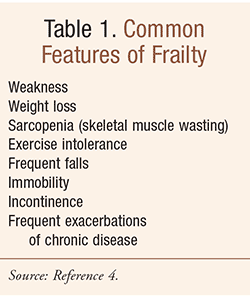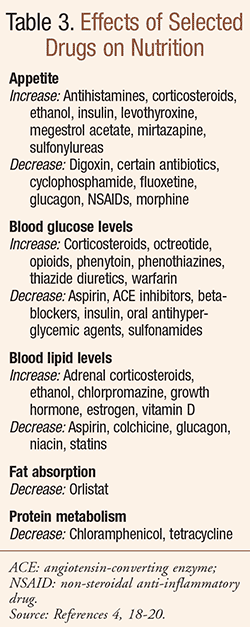Aging affects nutrition, and nutrition affects aging.1 Optimum nutrition in older adults can help them age healthfully and prevent frailty. The geriatrics community has been criticized by some researchers for focusing more on frailty than on the needs of the large population of seniors who are not yet frail and are interested in preserving high levels of health and vigor as long as possible.2 Addressing nutrition in older adults, and how it relates to medication therapy, is one way pharmacists can become more involved in the important effort of promoting healthy aging.
Nutrition and Aging
Optimal nutritional status occurs when there is a balance between nutrient intake and nutrient requirements. Less-than-optimal nutritional status in older adults can result from the following: 1) sub-optimal dietary intake; 2) age-related changes; 3) disease conditions and their treatment; or 4) other contextual factors such as cultural and religious beliefs, practices, and socioeconomic conditions.1
Age-related changes in economic and social status, such as retirement, a decrease in income, and living alone, can diminish the nutritional level of an older adult, leading to increased risk of illness, poor health, and limited mobility and independence.1 Increasing incidence of chronic disease (e.g., diabetes, cardiovascular disease, osteoporosis, arthritis, depression), changes in body systems and organ function (e.g., gastrointestinal, immune, sensory systems, dentition, mental capacity), and changes in body composition, including increased body fat, decreased lean body mass, and decreased bone mass can all contribute to poor nutritional status, increased risk of illness, and poor health.1 For example, being overweight can worsen symptoms of arthritis, while individuals with rheumatoid arthritis are at risk for being underweight.3
Nutritional Tips for Prevention of Frailty
The term frailty (TABLE 1) encompasses the loss of physiologic reserve, which renders people susceptible to disability due to minor stresses.4 Exercise and a healthy diet are recommended for preventing and reducing frailty; TABLE 2 addresses nutritional tips for frailty prevention. Malnutrition—that is, protein-energy malnutrition and micronutrient deficiency—is common in elderly adults; factors in undernutrition include the presence of cognitive decline or dementia, depression, chronic disease, or functional deficits.1 Successful nutritional intervention has been reported with the use of an interprofessional team approach (i.e., healthcare professional and social services); other interventions, such as exercise programs, have also proven beneficial in preventing the loss of skeletal muscle, known as sarcopenia, and its consequences related to functionality and independence as age advances.1,5 Sarcopenia is an important concept in geriatric healthcare, as it plays a predominant role in frailty, which increases the likelihood of falls, fractures, and hospitalizations that are associated with morbidity, disability, and death.6,7

Friedman et al indicate that certain projects have led to wide-scale improvements in nutrition, activity level, weight loss, and outcomes (e.g, increased life expectancy, lower healthcare costs).2 The Blue Zones Project for example, is a systems approach in which citizens, schools, employers, owners of restaurants and grocery stores, and community leaders collaborate on policies and programs that move the community toward better health and well-being.8 It encompasses the implementation of long-term, evidence-based policies and interventions, optimizes environments within communities, and gently signals people to make healthier choices throughout their day.
Vitamin B12 and Vitamin D
With increasing age, B vitamin status changes in a noteworthy way; low plasma concentrations of folate, cyanocobalamin (B12), and pyridoxine (B6) in the elderly may be associated with greater bone loss.9 Up to 30% of older adults are deficient in vitamin B12; individuals over the age of 50 need to consume more vitamin B12 or rely on supplements to avoid the malabsorption of food-bound B12.1 Individuals with cognitive decline associated with normal aging should be investigated for vitamin B12 deficiency.10 As for vitamin D deficiency, although it is widespread among all age groups, it is particularly high in older adults.11
Disability: Consider Obesity and Low Activity
The prevalence of obesity has increased at a steady rate since the late 1980’s; obesity is generally defined as an unhealthy excess of body fat characterized as a body mass index (BMI) >30 kg/m2.1 The cohort currently aging into the older adult population was found to have a rate of disability that increased from the 1980’s through the 1990’s.12 This rise in disability is attributed in part to declining activity levels and growing rates of obesity; these factors raise the risk of multimorbidity, including diabetes mellitus, hypertension, coronary artery disease, and hyperlipidemia.13-16 Healthcare professionals are always encouraged to identify problems that can be remedied; obesity is a prime example of a potentially remediable cause of symptoms and health conditions that may impair functional ability and cause a handicap.17
Interactions Between Drugs and Nutrients
Of particular interest to pharmacists is how nutrition can affect the body’s response to drugs, while at the same time, drugs can affect an individual’s nutrition (TABLE 3).4 The tables provided should assist pharmacists in guiding older adults.
Drug-food or drug-nutrient interactions can be categorized as follows18:
Physical interactions: Magnesium, calcium, iron, aluminum, or zinc can lower the oral absorption of levothyroxine and some quinolone antibiotics. The oral absorption of phenytoin and levothyroxine are decreased by tube feedings.
Decreased drug effect: A very common example is the decreased effect of warfarin with the consumption of vitamin K-containing foods (e.g., kale, spinach, brussels sprouts, parsley, collard greens, mustard greens, chard, green tea).
Decreased oral intake or appetite: Some medications, such as captopril and clarithromycin, can alter the taste of food (dysgeusia). Agents that reduce the production of saliva (xerostomia), which may cause difficulties in mastication and swallowing, include antihistamines, antidepressants, antipsychotics, clonidine, and diuretics.
Conclusion
According to Friedman et al, adults from the baby boom generation are known for their interest in health and physical fitness; they also have the desire to actively participate in their own healthcare.2 By educating seniors about healthy aging and nutritional ways to prevent frailty, pharmacists can serve this population and their caregivers through a more holistic and comprehensive approach to appropriate medication therapy.
REFERENCES
1. Johnson CS, Sacks G. Nutrition in Aging. In: Fillit HM, Rockwood K, Woodhouse K, eds. Brocklehurst’s Textbook of Geriatric Medicine and Gerontology. 7th ed. Philadelphia, PA: Saunders Elsevier; 2010:678-684.
2. Friedman SM, Shah K, Hall WJ. Failing to focus on healthy aging: a frailty of our discipline? J Am Geriatr Soc. 2015;63:1459-1462.
3. Mayo Clinic. Mayo Clinic on Arthritis. Rochester, MN: Mayo Foundation for Medical Education; 2013:255-278.
4. Porter RS, ed. The Merck Manual of Diagnosis and Therapy, 19th ed. Hoboken, NJ: Wiley; 2011: 6-11, 14-15, 3078-3079, 3086, 3110-3111.
5. Edington J, Barnes R, Bryan F, et al.: A prospective randomised controlled trial of nutritional supplementation in malnourished elderly in the community: clinical and health economic outcomes. Nutrition. 2004;23:195-204.
6. Rolland Y, Vellas B. Sarcopenia. In: Fillit HM, Rockwood K, Woodhouse K, eds. Brocklehurst’s Textbook of Geriatric Medicine and Gerontology. 7th ed. Philadelphia, PA: Saunders Elsevier; 2010:587-593.
7. Zagaria ME. Age-related sarcopenia. USPharm. 2015;40(5):16-18. www.uspharmacist.com/content/d/senior_care/c/54724.
8. BlueZones.com. Our approach. www.bluezones.com/services/our-approach. Accessed November 19, 2015.
9. McLean RR, Jacques PF, Selhub J, et al. Plasma B vitamins, homocysteine, and their relation with bone loss and hip fracture in elderly men and women. J Clin Endocrinol Metab. 2008;93:2206-2212.
10. Martin J, Gorenstein M. Normal cognitive aging. In: Fillit HM, Rockwood K, Woodhouse K, eds. Brocklehurst’s Textbook of Geriatric Medicine and Gerontology. 7th ed. Philadelphia, PA: Saunders Elsevier; 2010:170-177.
11. Shinchuk L, Holick MF. Vitamin D and rehabilitation: improving functional outcomes. Nut Clin Pract. 2007;22(3):297-304.
12. National Institutes of Health. Research Portfolio Online Reporting Tools (RePORT). NIH Fact Sheets. Disability in older adults. Updated on March 29, 2013. http://report.nih.gov/nihfactsheets/ViewFactSheet.aspx?csid=37. Accessed November 13, 2015.
13. Boyd CM, Fortin M. Future of multimorbidity research: how should understanding of multimorbidity inform health system design? Public Health Rev. 2010;32:451-474.
14. Mercer SW, Smith SM, Wyke S, et al. Multimorbidity in primary care: developing the research agenda. Fam Pract. 2009;26:79-80.
15. Boyd CM, Darer J, Boult C, et al. Clinical practice guidelines and quality of care for older patients with multiple comorbid diseases: implications for pay for performance. JAMA. 2005;294:716-724.
16. American Geriatrics Society Expert Panel on the Care of Older Adults with Multimorbidity. Patient-centered care for older adults with multiple chronic conditions: a stepwise approach from the American Geriatrics Society. J Am Geriatr Soc. 2012;60:1957-1968.
17. Zagaria ME. Obesity: reality and relevance to health. US Pharm. 2009;34(9):20-24. www.uspharmacist.com/content/d/senior care/c/15813.
18. Reuben DB, Herr KA, Pacala JT, et al. Geriatrics at Your Fingertips: 2015. 17th ed. New York, NY: The American Geriatrics Society; 2015:19.
19. Semla TP, Beizer JL, Higbee MD. Geriatric Dosage Handbook. 19th ed. Hudson, OH: Lexicomp; 2014.
20. Epocrates.com. Epocrates Plus Version 15.10. Updated November 10, 2015.
To comment on this article, contact rdavidson@uspharmacist.com.







